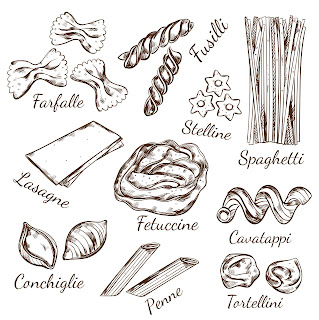STORY OF PASTA
Pasta is made from unleavened dough consisting of ground durum wheat and water or eggs. while we do think of pasta as culturally Italian food, it is likely the descendent of ancient Asian noodles. A common belief about pasta is that it was brought to Italy from China by Marco Polo during the 13th century.
HISTORY
In the 1st century AD writings of Horace, lagana (singular:
laganum) were fine sheets of fried doughand were an everyday foodstuff. Writing in the 2nd
century Athenaeus of
Naucratis provides a recipe for lagana which he
attributes to the 1st century Chrysippus of Tyana sheets of dough made of wheat
flour and the juice of crushed lettuce then flavored with spices and deep-fried
in oil. An early 5th-century cookbook describes a dish called
lagana that consisted of layers of dough with meat stuffing, an ancestor of
modern-day lasagna, However, the method of cooking these sheets of dough does
not correspond to our modern definition of either a fresh or dry pasta product,
which only had similar basic ingredients and perhaps the shape The first
concrete information concerning pasta products in Italy dates from the 13th or
14th century.
IN MODERN TIMES
The art of pasta making and the devotion to the food as a whole has evolved since pasta was first conceptualized. It is estimated that Italians eat over 27kg of pasta per person, per year, easily beating Americas, who eat about 9kg per person. Pasta is so beloved in Italy that individual consumption exceeds the average production of wheat of the country, thus Italy frequently imports wheat for pasta making. In contemporary society pasta is ubiquitous and individuals can find a variety of types in local supermarkets. With the worldwide demand for this staple food, pasta is now largely mass-produced in factories and only a tiny proportion is crafted by hand.


Comments
Post a Comment